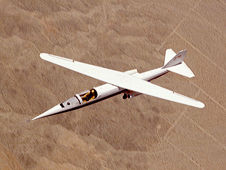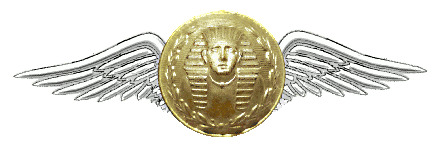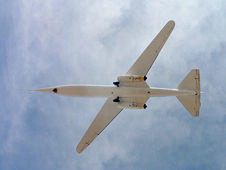A program conducted between 1979 and 1982 at the NASA Dryden Flight Research Center, Edwards, Calif., successfully demonstrated an aircraft wing that could be pivoted obliquely from zero to 60 degrees during flight. The unique wing was demonstrated on a small, subsonic jet-powered research aircraft called the AD-1 (Ames Dryden -1). The aircraft was flown 79 times during the research program, which evaluated the basic pivot-wing concept and gathered information on handling qualities and aerodynamics at various speeds and degrees of pivot.
The oblique wing concept originated with Robert T. Jones, an aeronautical
engineer at NASA’s Ames Research Center, Moffett Field, Calif.
Analytical and wind tunnel studies Jones initiated at Ames indicated that a transport-size oblique-wing aircraft, flying at speeds up to Mach 1.4 (1.4 times the speed of sound), would have substantially better aerodynamic performance than aircraft with more conventional wings. At high speeds, both subsonic and supersonic, the wing would be pivoted at up to 60 degrees to the aircraft’s fuselage for better high-speed performance. The studies showed these angles would decrease aerodynamic drag, permitting increased speed and longer range with the same fuel expenditure. At lower speeds, during takeoffs and landings, the wing would be perpendicular to the fuselage like a conventional wing to provide maximum lift and control qualities. As the aircraft gained speed, the wing would be pivoted to increase the oblique angle, thereby reducing the drag and decreasing fuel consumption. The wing could only be swept in one direction, with the right wingtip moving forward.
The AD-1 aircraft was delivered to Dryden in February 1979. The Ames Industrial Co., Bohemia, N.Y., constructed it, under a $240,000 fixed-price contract. NASA specified the overall vehicle design using a geometric configuration studied by the Boeing Commercial Airplane Company, Seattle, Wash. The Rutan Aircraft Factory, Mojave, Calif., provided the detailed design and load analysis for the intentionally low-speed, low-cost airplane. The low speed and cost of course limited the complexity of the vehicle and the scope of its technical objectives.

Piloting the aircraft on its first flight Dec. 21, 1979, was NASA research pilot Thomas C. McMurtry, who was also the pilot on the final flight Aug. 7, 1982. Powered by two small turbojet engines, each producing 220 pounds of static thrust at sea level, the aircraft was limited for reasons of safety to a speed of about 170 mph. The AD-1 was 38.8 feet in length and had a wingspan of 32.3 feet unswept. It was constructed of plastic reinforced with fiberglass, in a sandwich with the skin separated by a rigid foam core. It had a gross weight of 2,145 pounds, and an empty weight of 1,450 pounds. A fixed tricycle landing gear, mounted close to the fuselage to lessen aerodynamic drag, gave the aircraft a very « squatty » appearance on the ground. It was only 6.75 feet high. The wing was pivoted by an electrically driven gear mechanism located inside the fuselage, just forward of the engines.
Read full article on the NASA (www.nasa.gov) website: NASA Dryden Past Projects: AD-1 Oblique Wing – updated August 12, 2009


